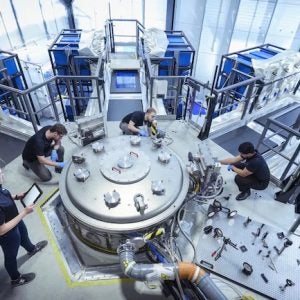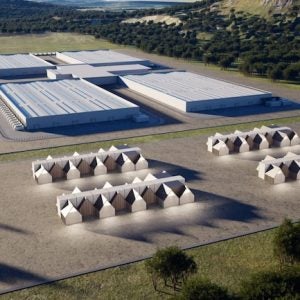Canada’s Terrestrial Energy said on 25 February that it is submitting its Integral Molten Salt Reactor (IMSR) design to the Canadian Nuclear Safety Commission (CNSC) for pre-licensing review – the first step towards an eventual licence application. Pre-licensing is not a required part of the licensing process for a new nuclear plant, but aims to verify the acceptability of a design with respect to Canadian nuclear regulatory requirements and expectations.
The review involves three phases: a pre-licensing assessment of compliance with regulatory requirements; an assessment of any potential fundamental barriers to licensing; and a follow-up phase allowing the vendor to respond to findings from the second phase. CNSC said the findings will be considered in any subsequent construction licence application, increasing the efficiency of technical reviews. Terrestrial Energy CEO Simon Irish said the review takes the company towards the submission of a formal licence application "to build and operate the first commercial demonstration Integral Molten Salt Reactor plant in the 2020s". Earlier this year Irish told World Nuclear News that the conceptual design stage of Terrestrial Energy’s IMSR is expected to be completed in 2017.
A molten salt test reactor operated at the USA’s Oak Ridge National Laboratory (ORNL) in the 1960s. Terrestrial Energy in January 2015 announced a collaboration with ORNL to develop its IMSR design to the engineering blueprint stage. Molten salt reactors (MSRs) use fuel dissolved in a molten fluoride or chloride salt which functions as both the fuel (producing the heat) and the coolant (transporting the heat away and ultimately to the power plant). This means that such a reactor could not suffer from a loss of coolant leading to a meltdown.
The MSR concept was developed at ONRL in the 1960s, but it has never been developed commercially. Terrestrial raised $10m in January in its first major financing and says it hopes to change that, with a design that will be cost-competitive with fossil fuels. "We’re not looking to build a reactor in a laboratory," said Irish. "We’re just taking a reactor design off the shelf, taking it out of national lab, and we’re seeking to commercialize it."
The US is also looking to develop MSRs. In January, the Department of Energy (DOE) awarded multi-year cost-share funding worth up to a total of $80m to support X-energy’s Xe-100 Pebble Bed Advanced Reactor and Southern Company Services’ Molten Chloride Fast Reactor (MCFR). The projects were selected following a competitive process. The DOE’s initial investment will be $6m for each project.
Southern Company Services, a subsidiary of Southern Company, is developing the MCFR in partnership with TerraPower, Electric Power Research Institute, Vanderbilt University, and ORNL. The funding will be used to perform integrated effects tests and materials suitability studies to support reactor development.
Last October, Chinese and American scientists met at ONRL to observe the 50th anniversary of the molten-salt reactor experiments conducted there. The 50th anniversary workshop, included presentations from reactor developers including TerraPower, Flibe Energy, Moltex Energy, and Terrestrial Energy, as well as Southern Power.
Xu Hongjie, the director of the MSR programme at the Shanghai Institute of Applied Physics (SINAP), also addressed the meeting. Under the auspices of the Chinese Academy of Sciences, SINAP is collaborating with ORNL to advance research on both salt-cooled reactors (which use molten salts to transfer heat and to cool the reactor) and salt-fuelled reactors (in which the fuel, where the energy-producing nuclear reactions occur, is dissolved within the salt coolant).
Xu detailed a multi-stage plan to build demonstration reactors in the next five years and deploy them commercially beginning around 2030. The institute plans to build a 10MW prototype reactor, using solid fuel, by 2020, along with a 2MW liquid-fuel machine that will demonstrate the thorium-uranium fuel cycle. He said there are 700 nuclear engineers working on the MSR at SINAP. The team has a preliminary design for a 10MW thorium-based MSR, and has mastered some of the technical challenges involved in building and running such reactors, such as the preparation of high-purity molten salts and the control of tritium – a key research goal for MSR development.
SINAP’s MSR research is funded until 2017, he says; beyond that the institute is seeking new funding from the central government, the Shanghai government, and the private sector. SINAP also recently signed an agreement with Fangda Group, a major Chinese conglomerate that produces carbon products, iron and steel, and chemicals, to help develop molten-salt coolants for the reactors.
In September 2015, a consortium of research institutes and universities working with the European Commission began a four-year research programme designed to demonstrate the safety benefits of MSRs. This Safety Assessment of the Molten Salt Fast Reactor (Samofar), could lead to the building of a prototype reactor in the early 2020s, according to MIT Technology Review. The consortium includes the Technology University of Delft (TU Delft) in the Netherlands, France’s National Centre for Scientific Research, and the Commission’s Joint Research Centre in Brussels. TU Delt said one of the key challenges of the Samofar project is to understand the heat transfer in molten salt reactors during a range of conditions, both nominal and accidental.






